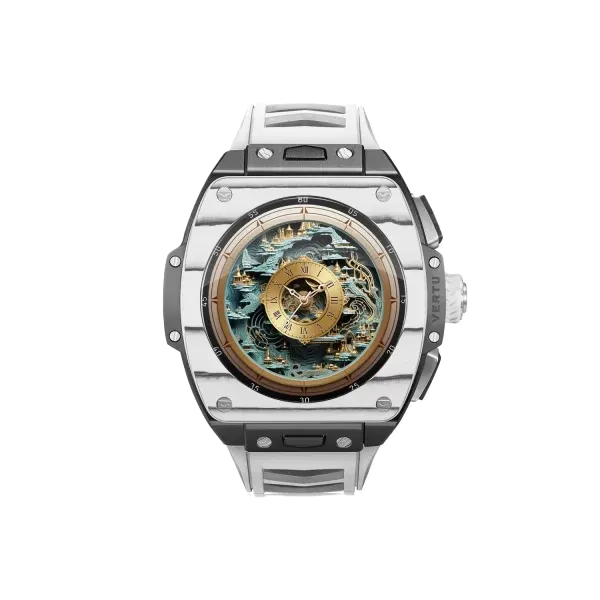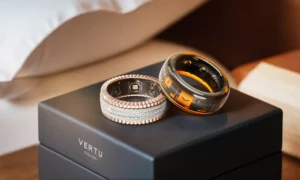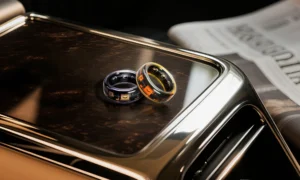Have you ever wanted to check your blood pressure anytime, anywhere, without the hassle of a traditional cuff? That future is here.
Smartwatches are revolutionizing personal health management. Moving beyond step counting and heart rate, the latest 2025 models offer a new level of convenience and accuracy in blood pressure monitoring.
Key Takeaways: What You'll Learn
-
The Science: Understand the core technologies like Photoplethysmography (PPG) and Pulse Transit Time (PTT).
-
FDA Clearance: Learn why regulatory approval is a game-changer for accuracy.
-
Choosing Your Watch: Discover key features and leading brands in the 2025 market.
-
Best Practices: Master the techniques for getting reliable and accurate readings.
-
Smartwatch vs. Cuff: Know the distinct advantages of each and how they complement one another.
-
The Future: Get a glimpse into what AI and new sensor tech will bring next.
How Do Smartwatches Measure Blood Pressure in 2025?
In 2025, smartwatches primarily use two sophisticated methods to estimate your blood pressure, moving far beyond simple guesswork.
First is Photoplethysmography (PPG), the foundational technology. The green lights on the back of your watch are PPG sensors. They shine light into your skin and measure how much light is reflected back. As your blood flows, the volume of your blood vessels changes, altering the light reflection.
“PPG technology generates a pulse waveform by capturing changes in blood volume. These waveforms are key data points for analyzing cardiovascular health.” — Medical Technology Expert
Second is the more advanced Pulse Transit Time (PTT). This is the time it takes for a pulse wave to travel from your heart to your wrist. PTT has an inverse relationship with blood pressure: higher blood pressure means stiffer arteries, which makes the pulse wave travel faster, resulting in a shorter PTT.
To calculate PTT, a smartwatch combines two sensors:
-
An ECG (electrocardiogram) sensor detects the exact moment your heart beats.
-
A PPG sensor detects when the resulting pulse wave arrives at your wrist.
The time difference between these two events is the PTT, which is then used to calculate your blood pressure.
Why is Calibration Crucial for Smartwatch Blood Pressure Accuracy?
Despite these advanced technologies, most blood pressure smartwatches in 2025 still require regular calibration to ensure their readings are accurate. Calibration involves comparing the watch's reading to a measurement from a traditional, validated medical cuff.
-
Initial Calibration: This is a critical first step to align the smartwatch's algorithm with your unique physiology.
-
Periodic Calibration: It is recommended to recalibrate every few weeks or once a month. This accounts for changes in your body and potential wear on the device.
Without proper calibration, a smartwatch's blood pressure readings can have significant deviations, making them unreliable for tracking your health.
What Does FDA Clearance Mean for a Blood Pressure Smartwatch?
As smartwatches become more advanced, they are increasingly scrutinized by regulatory bodies like the U.S. Food and Drug Administration (FDA).
It's important to understand the difference between “FDA Clearance” and “FDA Approval.” Most health-focused smartwatches receive FDA Clearance (510(k)). This means the device has been proven to be “substantially equivalent” to another legally marketed device that is already considered safe and effective. FDA Approval (PMA) is a more rigorous process reserved for high-risk, novel medical devices.
By 2025, many leading smartwatch brands have obtained FDA Clearance for their blood pressure features. This signifies that the device has undergone clinical validation, where its accuracy was tested against medical-grade equipment in a controlled environment, ensuring its reliability for consumers.
Are Smartwatches Diagnostic Tools for High Blood Pressure?
No. It is critical to remember that even in 2025, smartwatches are considered health monitoring tools, not medical diagnostic devices.
“Smartwatches provide valuable trend data and can serve as an early warning system, but they are not a substitute for professional medical diagnosis. Any abnormal readings should be confirmed by a doctor.” — Statement from a leading medical authority.
You should not use smartwatch data alone to make medical decisions or adjust medication. Their purpose is to help you track trends and stay informed, empowering you to have a more productive conversation with your healthcare provider.
How to Choose the Best Blood Pressure Smartwatch in 2025
Selecting the right device involves looking beyond just blood pressure and considering the entire health ecosystem.
Integrated Health Features
A top-tier smartwatch provides a holistic view of your health by integrating multiple functions:
-
Continuous Heart Rate Monitoring
-
ECG for detecting atrial fibrillation (AFib)
-
Blood Oxygen (SpO2) for respiratory health
-
Sleep Tracking and quality analysis
-
Advanced Fitness Tracking
Data Integration and Compatibility
Ensure the watch and its app work seamlessly with your digital life. Look for compatibility with major health platforms like Apple Health or Google Fit to consolidate all your health data in one place.
What are the Leading Brands for Blood Pressure Smartwatches?
As of 2025, several brands have distinguished themselves in the blood pressure monitoring space, many with the necessary regulatory clearance.
| Brand / Model | Blood Pressure Method | Key Features | Calibration | Est. Price |
| Samsung Galaxy Watch (Latest) | PTT + Calibration | ECG, SpO2, BIA | Periodic | Mid-High |
| Huawei Watch (Latest) | Cuff-style or PTT | ECG, SpO2, Skin Temp | Some models are calibration-free | Mid |
| Omron HeartGuide (Updated) | Oscillometric Wrist Cuff | Medical-grade accuracy | None needed | High |
| Withings ScanWatch (Updated) | PTT + Calibration | ECG, SpO2, Sleep Apnea | Periodic | Mid-High |
What are the Best Practices for Getting Accurate Readings?
To ensure your data is as reliable as possible, follow these best practices.
-
Ensure a Proper Fit: The watch should be snug but not tight, about two fingers' width above your wrist bone. It should not slide around.
-
Calibrate Routinely: Follow the manufacturer's instructions for regular calibration with a traditional cuff. Keep a log of your calibration dates.
-
Maintain Optimal Conditions: For consistent trend data, measure at the same time each day, such as in the morning and before bed. Rest for at least 5 minutes beforehand, and avoid caffeine, smoking, or exercise. During the measurement, stay still, quiet, and keep your wrist at heart level.
Smartwatch vs. Traditional Cuff: Which One Do You Need?
Smartwatches and traditional blood pressure cuffs serve different but complementary roles in your health journey.
| Feature / Device | Smartwatch Blood Pressure Monitor | Traditional Cuff Blood Pressure Monitor |
| Portability | Extremely high, worn daily | Low, requires a specific setting |
| Frequency | High-frequency or continuous monitoring | Typically 1-2 times daily |
| Accuracy | Good (with calibration) | Very High (medical standard) |
| Functionality | Multiple integrated health features | Single-function (blood pressure) |
| Trend Tracking | Excellent, automatic logging | Manual logging or specific models |
The best approach is to use both. Use a smartwatch for daily trend monitoring and early detection, and use a traditional cuff for medical accuracy, diagnosis, and calibrating your watch.
What is the Future of Blood Pressure Monitoring?
The technology is advancing rapidly. By the end of 2025 and beyond, expect to see:
-
AI and Machine Learning: AI will analyze vast amounts of PPG data to create highly personalized and predictive blood pressure algorithms.
-
Calibration-Free Technology: The ultimate goal is to develop new sensors and multi-parameter analysis techniques that eliminate the need for regular calibration.
-
Evolving Regulations: Expect clearer global standards for the accuracy and validation of consumer health devices.
Frequently Asked Questions (FAQ)
Q: How accurate are smartwatches for blood pressure? Can they replace a traditional cuff?
A: In 2025, smartwatches with FDA clearance are highly accurate for tracking trends. However, they cannot replace a traditional cuff, especially for diagnosing hypertension or managing medication. They are best used as a complementary monitoring tool.
Q: Why do I need to calibrate my smartwatch?
A: Most smartwatches use indirect methods (PPG/PTT) that are influenced by individual physiology. Calibration uses a direct measurement from a traditional cuff to personalize the watch's algorithm, ensuring its readings are true to your body.
Q: Can a smartwatch diagnose high blood pressure?
A: No. A smartwatch is a monitoring tool, not a diagnostic one. A diagnosis of hypertension must be made by a qualified doctor using a medical-grade device.
Q: How often should I calibrate my smartwatch?
A: Follow the manufacturer's guidelines, but a good rule of thumb is every few weeks to once a month, or if you suspect the readings are inaccurate.
Q: Can I share my smartwatch blood pressure data with my doctor?
A: Yes, and you absolutely should. Most companion apps can generate health reports that you can share with your doctor. This long-term trend data is incredibly valuable for your healthcare provider.
Conclusion
In 2025, the smartwatch has firmly established itself as an essential tool for personal health management. With remarkable advances in blood pressure monitoring, these devices empower us with convenience and ever-improving accuracy.
While they don't replace professional medical equipment, smartwatches are invaluable allies for daily monitoring and long-term trend analysis, playing a vital role in the prevention and management of cardiovascular health.
Ready to take control of your health? Explore the latest blood pressure smartwatches and start your journey to smarter health monitoring today.







